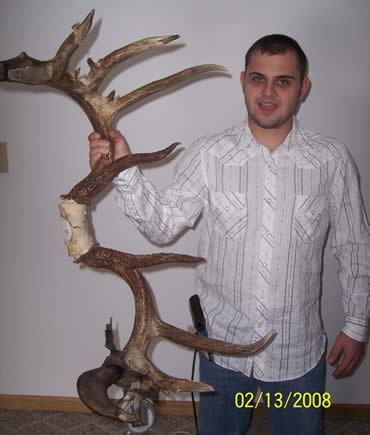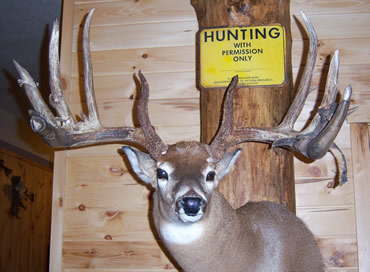If Ben Knisley had a doe tag, this story might never have happened.
If Ben Knisley had drawn a doe tag in 2006, the winner of Buckmasters’ Golden Laurel Citation would not have hailed from Minnesota. But the 23-year-old from Paynesville couldn’t shoot any of the does that came his way on the afternoon of Nov. 4. He was forced to wait for the fourth whitetail to take the stage.
Three shots later, the list of bucks known for the hunters who bagged them — Breen, Hanson, Collora and Zaft — grew longer. The Knisley Buck’s proportions earn it a spot among the greatest whitetails of all time.
Ben, who makes no claim of being a trophy hunter, had no idea the buck would raise so many eyebrows. It could’ve been half as big, and he’d have been eager to shoot it. Success for him is being able to be in the woods — all the better if the outing produces a deer for the freezer.
Opening Day to Remember
It might have been opening day of Minnesota’s firearms season, one of the most anticipated annual events in Ben’s life, but he didn’t decide where he was going to spend it until he was dressed. He wound up going to his dad’s Meeker County farm.
The bitter-cold morning was uneventful, so Ben drove to his Uncle Dick’s farm about 15 miles outside of Paynesville. He wanted to see if Dick had any luck that morning.
After sharing a quick bite to eat, Ben and his uncle decided to hunt together for the rest of the day. They headed for a piece of property that Dick owns about a quarter-mile from his house.
Ben asked if it would be okay to hunt a stand that he had visited many times before. He liked the way it was positioned. Dick, of course, did not mind, but he asked his nephew to wait long enough for him get to his own stand.
 Shortly after Dick had settled in for the afternoon, he heard deer moving in the distance. He eventually heard grunting, too. Hoping to attract the deer, he also grunted.
Shortly after Dick had settled in for the afternoon, he heard deer moving in the distance. He eventually heard grunting, too. Hoping to attract the deer, he also grunted.
Although the deer were close, Dick never saw them. Ultimately, they moved off to the south.
Ben was just enjoying being out in the woods. He had no idea that history was walking his way until his daydreaming was interrupted by the sound of approaching deer.
Ben tightened his grip on his .54-caliber Hawken, but he exhaled as soon as the three does appeared. Since he hadn’t drawn a doe tag, they were as safe as if they’d been in God’s back pocket. The hunter was calmly enjoying the sight when yet more movement caught his attention.
A buck.
Ben didn’t take a lot of time to study the antlers. All he wanted to do was shoot it. If the buck continued along the path the does had taken, it would pass within 40 yards. When it did, Ben’s sights drifted over the buck’s shoulder.
The buck whirled at the shot, ran 40 yards and stopped.
Ben cleaned and reloaded his muzzleloader, and then fired again. That time, the buck ran another 100 yards to the edge of a cornfield. Ben was confident that he’d connected at least once, but that wasn’t going to stop him from trying a third time, even if it was a long shot.
After another cleaning and reloading, he squeezed the Hawken’s trigger. And after the smoke drifted, all was silent until Uncle Dick arrived.
 The two men walked to the edge of the cornfield and marveled over the fallen whitetail. At first glance, Dick thought the antlers had corn stalks tangled in them. But this turned out to be massive hunks of dried velvet — even more character for a rack that already had plenty.
The two men walked to the edge of the cornfield and marveled over the fallen whitetail. At first glance, Dick thought the antlers had corn stalks tangled in them. But this turned out to be massive hunks of dried velvet — even more character for a rack that already had plenty.
Just How Big is It?
It’s hard to imagine how impressive the Knisley Buck is without seeing these incredible antlers in person. Every whitetail fanatic who has seen them is rendered almost speechless.
Famed West Virginia antler replicator and taxidermist Jack Comp measured the rack for Buckmasters. Dave Boland, who has taped close to 1,300 heads for the Boone and Crockett Club, did the honors for that organization. Both men have said this deer is the most impressive — on the typical end of the spectrum — they’ve ever held.
Antler collector Dan Cole compared the Knisley to the Breen Buck, the 202-inch (B&C) Minnesota state record taken back in 1918.
The Knisley rack is taller, wider and heavier.
The Knisley Buck stands shoulder to shoulder with other legendary bucks as well. In the main beam and overall mass departments, it beats the Milo Hanson, Wayne Zaft, Sam Collora and Mel Johnson bucks. It also wears the longest tine, a 15-incher, among these giants. In fact, the only whitetail in the BTR records that might be considered more impressive is a pair of nearly 50-year-old sheds from Nebraska, known as “The General” (listed in Buckmasters’ record book under owner Brad Gsell’s name). Even so, The General would fit inside the Knisley Buck’s antlers.
In BTR terms, however, comparing the Knisley to any of the bucks mentioned above could be like setting an apple beside an orange.
The BTR has four instead of two antler classifications, and simple math determines in which a rack falls. Since abnormal or irregular points contribute 6.1 percent to the Knisley Buck’s official score, it’s considered a Semi-irregular. All the legendary bucks mentioned thus far are classified as either Typicals or Perfects.
So how does Ben Knisley’s deer rate among Semi-irregulars?
If one looks only at the official scores, the Knisley buck is No. 3 among blackpowder bucks in this category. However, the two deer above it benefit from 8.2 and 9.8 percent irregularity, meaning the Knisley rack has a far stronger typical mainframe.
Limiting comparisons to other Semi-irregulars with similar percentages, the Knisley Buck would be seventh in the world among all weapons categories. And it still has the lowest percentage of irregularity in the bunch.
All this is precisely why the Knisley Buck was chosen as the 2008 recipient of the prestigious Golden Laurel Citation, awarded annually to the most significant entry into “Buckmasters Whitetail Trophy Records.” It’s also why the giant from Meeker County, Minn., is destined to be a legend.
Read Recent Articles: • For Better or Worse: Whitetail hunters should know better than to schedule a wedding during deer season.
• Anatomy of a Buck Rub: Not all rubs will produce bucks, but they all tell a story about the deer who make them.
• Why QDM Isn’t Working for You: There are plenty of reasons QDM works ... and just as many as to why it can fail.
This article was published in the August 2008 edition of Buckmasters Whitetail Magazine. Join today to have Buckmasters delivered to your home.